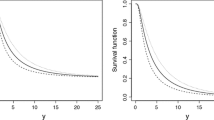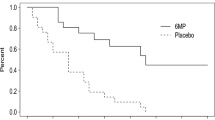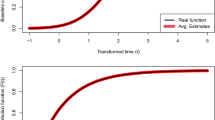Abstract
In survival analysis, Cox PH cure model has attracted attention for decades. The profile likelihood approach is one of the well known estimation methods employed within the Cox PH cure modeling framework. Typically, the parameters in the profile likelihood are estimated using expectation maximization (EM) algorithm. However, there is a challenge in estimating the standard error (SE) of the estimator in the profile likelihood method. In this paper, we propose a new approach to show the asymptotic normality of the maximum profile likelihood estimator and obtain the closed form expression for the SE of the estimator. Real data example and simulation studyshowed that our method is more computationally efficient and performs better in estimating standard errors compared with the bootstrap methods in ‘smcure’ package (Cai et al. 2012).
Similar content being viewed by others
Data availability
The data that support the findings of Section-6 are openly available at Cai et al. (2012).
References
Amico M, Van Keilegom I (2018) Cure models in survival analysis. Ann Rev Stat Appl 5:311–342
Cai C, Zou Y, Peng Y, Zhang J (2012) smcure: an R-Package for estimating semiparametric mixture cure models. Comput Methods Programs Biomed 108(3):1255–1260
Dempster AP, Laird NM, Rubin DB (1977) Maximum likelihood from incomplete data via the EM algorithm. J R Stat Soc Ser B 1:1–38
Efron B, Tibshirani RJ (1994) An introduction to the bootstrap. CRC Press, London
Fang HB, Li G, Sun J (2005) Maximum likelihood estimation in a semiparametric logistic/proportional-hazards mixture model. Scand J Stat 32(1):59–75
Farewell VT (1982) The use of mixture models for the analysis of survival data with long-term survivors. Biometrics 38:1041–1046
Fleming TR, Harrington DP (1991) Counting processes and survival analysis. Wiley, New York, p 169
Hirose Y (2011) Efficiency of profile likelihood in semi-parametric models. Ann Inst Stat Math 63(6):1247–1275
Hsieh F, Tseng Y-K, Wang J-L (2006) Joint modeling of survival and longitudinal data: likelihood approach revisited. Biometrics 62(4):1037–1043
Kuk AY, Chen CH (1992) A mixture model combining logistic regression with proportional hazards regression. Biometrika 79(3):531–541
Lu W (2008) Maximum likelihood estimation in the proportional hazards cure model. Ann Inst Stat Math 60(3):545–574
Murphy SA, Van der Vaart AW (2000) On profile likelihood. J Am Stat Assoc 95(450):449–465
Othus M, Barlogie B, LeBlanc ML, Crowley JJ (2012) Cure models as a useful statistical tool for analyzing survival. Clin Cancer Res 18:3731
Peng Y, Dear KB (2000) A nonparametric mixture model for cure rate estimation. Biometrics 56(1):237–243
Rizopoulos D (2012) Joint models for longitudinal and time-to-event data: with applications in R. Chapman and Hall/CRC
Sy JP (1994) A mixture model in survival analysis using cox proportional hazards regression and a binary mixing distribution. PhD thesis. Available from ProQuest One Academic (304099195)
Sy JP, Taylor JM (2000) Estimation in a Cox proportional hazards cure model. Biometrics 1:227–236
Sy JP, Taylor JM (2001) Standard errors for the Cox proportional hazards cure model. Math Comput Model 33(12–13):1237–1251
Van der Vaart AW (2000) Asymptotic statistics, vol 3. Cambridge University Press, Cambridge
Van Der Vaart AW, Wellner JA (1996) Weak convergence and empirical processes. Springer, Berlin, pp 16–28
Zhao X, Zhou X (2006) Proportional hazards models for survival data with long-term survivors. Stat Probab Lett 76(15):1685–1693
Funding
No funding.
Author information
Authors and Affiliations
Corresponding author
Ethics declarations
Conflict of interest
The authors declare that they have no competing interest.
Consent for publication
Not applicable.
Additional information
Publisher's Note
Springer Nature remains neutral with regard to jurisdictional claims in published maps and institutional affiliations.
Supplementary Information
Below is the link to the electronic supplementary material.
Rights and permissions
Springer Nature or its licensor (e.g. a society or other partner) holds exclusive rights to this article under a publishing agreement with the author(s) or other rightsholder(s); author self-archiving of the accepted manuscript version of this article is solely governed by the terms of such publishing agreement and applicable law.
About this article
Cite this article
Mohammad, K.A., Hirose, Y., Surya, B. et al. Profile likelihood estimation for the cox proportional hazards (PH) cure model and standard errors. Stat Papers 65, 181–201 (2024). https://doi.org/10.1007/s00362-022-01387-9
Received:
Revised:
Accepted:
Published:
Issue Date:
DOI: https://doi.org/10.1007/s00362-022-01387-9




